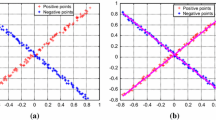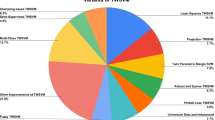Abstract
For multi-class classification problem, a novel algorithm, called as multiple birth support vector machine (MBSVM), is proposed, which can be considered as an extension of twin support vector machine. Our MBSVM has been compared with the several typical support vector machines. From theoretical point of view, it has been shown that its computational complexity is remarkably low, especially when the class number K is large. Based on our MBSVM, the dual problems of MBSVM are equivalent to symmetric mixed linear complementarity problems to which successive overrelaxation (SOR) can be directly applied. We establish our SOR algorithm for MBSVM. The SOR algorithm handles one data point at a time, so it can process large dataset that need no reside in memory. From practical point of view, its accuracy has been validated by the preliminary numerical experiments.

Similar content being viewed by others
References
Cortes C, Vapnik V (1995) Support-vector network. Mach Learn 20:273–297
Vapnik V (1998) The nature of statistical learning, 2nd edn. Springer, New York
Jayadeva R, Khemchandani R, Chandra S (2007) Twin support vector machine for pattern classification. IEEE Trans Pattern Anal Mach Intell 29(5):905–910
Mangasarian OL, Wild EW (2006) Multisurface proximal support vector classification via generalized eigenvalues. IEEE Trans Pattern Anal Mach Intell 28(1):69–74
Balasundaram S, Kapil N (2010) Application of lagrangian twin support vector machines for classification. Second international conference on machine learning and computing, pp 193–397
Ghorai S, Mukherjee A, Dutta PK (2009) Nonparallel plane proximal classifier. Signal Process 89:510–522
Jayadeva R, Khemchandani R, Chandra S (2009) Optimal kernel selection in twin support vector machines. Optim Lett 3:77–88
Kumar MA, Gopal M (2008) Application of smoothing technique on twin support vector machines. Pattern Recognit Lett 29:1842–1848
Kumar MA, Khemchandani R, Gopal M, Chandra S (2010) Knowledge based least squares twin support vector machines. Inf Sci 180:4606–4618
Peng XJ (2010) Least squares twin support vector hypersphere (LS-TSVH) for pattern recognition. Expert Syst Appl 37:8371–8378
Peng XJ (2010) TSVR: an efficient twin support vector machine for regression. Neural Netw 23:365–372
Peng XJ (2010) Primal twin support vector regression and its sparse approximation. Neurocomputing 73(16–18):2846–2858
Peng XJ (2010) A ν-twin support vector machine (ν-TSVM) classifier and its geometric algorithms. Inf Sci 180(20):3863–3875
Shao YH, Zhang CH, Wang XB, Deng NY (2011) Improvoments on twin support vector machine. IEEE Trans Neural Netw 22(6):962–968
Ye QL, Zhao CX, Ye N (2010) Least squares twin support vector machine classification via maximum one-class within class variance. Optimization methods and software, 18 August
Ye QL, Zhao CX, Ye N, Zheng H, Chen XB (2010) A feature selection method for nonparallel plane support vector machine classification. Optimization methods and software, 29 November
Ye QL, Zhao CX, Ye N, Chen XB (2011) Localized twin SVM via convex minimization. Neurocomputing 74:580–587
Nemmour H, Chibani Y (2006) Multi-class SVMs based on fuzzy integral mixture for handwritten digit recognition. Geometric modeling and imaging—new trends, pp 145–149
Rogers S, Girolami M, Krebs R, Mischak H (2005) Disease classification from capillary electrophoresis: mass spectrometry. Lect Notes Comput Sci 3686:183–191
Ding CH, Dubchak I (2001) Multi-class protein fold recognition using support vector machines and neural networks. Bioinform Biol Insights 17:349–358
Allwein EL, Schapire RE, Singer Y (2001) Reducing multiclass to binary: a unifying approach for margin classifiers. J Mach Learn Res 1:113–141
Bennett KP (1999) Combining support vector and mathematical programming methods for classification. In: Scholkopf B, Burges CJC, Smola AJ (eds) Advances in Kernel methods: support vector learning. MIT Press, Cambridge, MA, pp 307–326
Crammer K, Singer Y (2002) On the learnability and design of output codes for multiclass problems. Mach Learn 47:201–233
Dietterich TG, Bakiri G (1995) Solving multiclass learning problems via error-correcting output codes. J Artif Intell Res 2:263–286
Hastie TJ, Ribshirani RJ (1998) Classification by pairwise coupling. In: Jordan MI, Kearns MJ, Solla SA (eds) Advances in neural information processing systems 10. MIT Press, Cambridge, MA, pp 507–513
Kreβ U (1999) Pairwise classification and support vector machines. In: Scholkopf B, Burges CJC, Smola AJ (eds) Advances in Kernel methods: support vector learning. MIT Press, Cambridge, MA, pp 255–268
Platt JC, Cristianini N, Shawe-Taylor J (2000) Large margin DAGs for multiclass classification. Adv Neural Inf Process Syst 12:547–553
Crammer K, Singer Y (2002) On the algorithmic implementation of multiclass kernel-based vector machines. J Mach Learn Res 2:265–292
Lee Y, Lin Y, Wahba G (2001) Multicategory support vector machines. Comput Sci Stat 33:498–512
Weston J, Watkins C (1998) Multi-class support vector machines. CSD-TR-98-04 royal holloway. University of London, Egham, UK
Mangasarian OL, Musicant DR (1999) Successive overrelaxation for support vector machines. IEEE Trans Neural Netw 10(5):1032–1037
Bottou L, Cortes C, Denker JS, Drucher H, Guyon I, Jackel LD, LeCun Y, M\(\ddot{u}\)ller UA, Sackinger E, Simard P, Vapnik V (1994) Comparison of classifier methods: a case study in handwriting digit recognition. In: IAPR (eds) Proceedings of the international conference on pattern recognition. IEEE Computer Society Press, pp 77–82
Moreira M, Mayoraz E (1998) Improved pairwise coupling classification with correcting classifiers. In: Nédellec C, Rouveirol C (eds) Proceedings of the ECML-98. Chemnitz, Germany, pp 160–171
Platt JC (1999) Probabilistic outputs for support vector machines and comparisons to regularized likelihood methods. In: Smola AJ, Bartlett P, Schölkopf B, Schuurmans D (eds) Advances in large margin classifiers. MIT Press, Cambridge, MA
Golub GH, Van Loan CF (1996) Matrix computations, 3rd edn. The John Hopkins University Press, Baltimore
Fung G, Mangasarian OL (2001) Proximal support vector machine classifiers. In: 7th International proceedings on knowledge discovery and data mining, pp 77–86
Luo ZQ, Tseng P (1993) Error bounds and convergence analysis of feasible descent methods: a general approach. Ann Oper Res 46:157–178
Hsu CW, Lin CJ (2002) A comparison of methods for multiclass support vector machines. IEEE Trans Neural Netw 13(2):415–425
Blake CL, Merz CJ (1998) UCI repository of machine learning databases. Technical Report University of California, Department of Information and Computer Science, Irvine, CA. Available at: http://www.ics.uci.edu/mlearn/MLRepository.html
Author information
Authors and Affiliations
Corresponding author
Additional information
This work is supported by the National Natural Science Foundation of China (No.11161045) and Zhejiang Provincial Natural Science Foundation of China (No. LQ12A01020).
Rights and permissions
About this article
Cite this article
Yang, ZX., Shao, YH. & Zhang, XS. Multiple birth support vector machine for multi-class classification. Neural Comput & Applic 22 (Suppl 1), 153–161 (2013). https://doi.org/10.1007/s00521-012-1108-x
Received:
Accepted:
Published:
Issue Date:
DOI: https://doi.org/10.1007/s00521-012-1108-x




